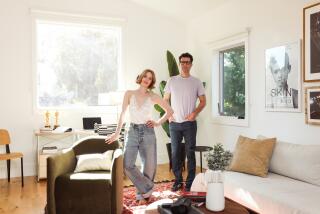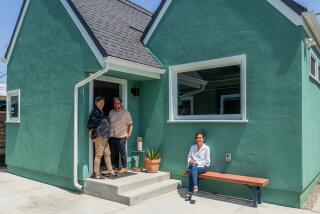Jewish Home for Aging to Study Mental Loss, Give Care to Victims
When Leon Seaman was 90 and his wife, Ruth, not yet 80, he confronted her one day at the door of their Palm Springs home.
“Don’t come with me,” he angrily told her that day five years ago. “I have my cane, I don’t want to hurt you, but I have to go to the police. My wife stole my money.”
After months of more insults, Ruth Seaman started thinking about a divorce. She thought about it for several years until she read a book that defined her husband’s problem as Alzheimer’s disease, an irreversible nerve disorder that blights memory and leaves its victims confused and helpless.
Now she chronicles her husband’s days in a growing pile of spiral notebooks that weighs, she says, “about five pounds.” She plans to share the journal with a group of UCLA medical students who will study dementia--the loss of mental powers--in a new special-care unit that has been opened in Reseda at the Jewish Homes for the Aging of Greater Los Angeles.
Amid woeful ignorance about dementia, the month-old unit will serve as a teaching and research facility and as a care unit for some of the 850 residents of the Jewish Homes, said its co-directors, gerontologists Joseph Ouslander and Dan Osterweil. Both physicians are full-time faculty members at UCLA medical school.
120-Bed Facility
Started with a $1-million endowment from the Maurice Amado Foundation, the 120-bed unit is housed in two buildings that are part of the Jewish Homes’ Victory Boulevard complex. The task of raising another $4 million to complete and operate the nonprofit facility will fall to Ernest A. Goldenfeld, newly installed president for 1988 of the Jewish Homes.
The need to add a dementia unit to the complex of retirement apartments and nursing beds was great, Ouslander said. The average Jewish Homes resident is 88, he said, an age at which one in four Americans has severe dementia, according to the Congressional Office of Technology Assessment.
Geriatric ailments are increasing as Americans live longer and the nation’s population grows older, but experts say the Jewish Homes unit is one of only a handful in the Los Angeles area for patients with dementia. The disorder can be brought on by Alzheimer’s disease, multiple small strokes in the brain or other ailments.
A similar unit opened 18 months ago at the Motion Picture and Television Country House and Hospital, a nonprofit retirement community for film industry workers in Woodland Hills. In November, Westwood’s John Douglas French Foundation for Alzheimer’s Disease opened the nation’s first hospital entirely devoted to the disease in Los Alamitos.
Elsewhere in the nation, treatment centers for dementia are equally rare. Of some 20,000 nursing homes in the United States, Ouslander said, fewer than 100 have dementia units.
Most hospitals and nursing homes are loathe to provide the laborious and unpleasant care demented patients need: wiping drool, changing diapers, chasing aimless wanderers, coping with bottomless despair, enduring insults, struggling to calm incoherent terror.
“It’s easier,” Osterweil says, “to zonk somebody out with some severe medications.”
At the Jewish Homes, finance director Debe Holzer said the cost of caring for a bedridden patient was about $40,000 last year. Federal entitlement programs covered about two-thirds of the cost, she said, while donations and endowments made up the difference.
Although care in the dementia unit will cost another $2,500 annually for each patient, Holzer said, federal programs will not pay for it. The staff hopes donations will.
“The cost is high,” notes Judy Wunsch, Los Angeles chapter coordinator of volunteers for the Alzheimer’s Disease and Related Disorders Assn., “and it isn’t covered by insurance . . . and there’s no end. The disease can’t be cured.”
But as many as one in every five dementia patients can improve with treatment, Ouslander said. Sometimes, cutting back on frequently used sedatives helps.
Moreover, he said, careful diagnosis can detect patients who are mislabeled as demented when the problem is that they cannot hear.
The new unit requires no miracle machines, Ouslander said. Instead, specially trained staff members will diagnose candidates for admission and pay great attention to each patient.
“We’re at the lowest levels here in trying to improve nursing care,” he said.
Although the unit is 75% occupied, trained staff is in short supply and many physical details need attention. Double latches on a gate were improperly installed, fluorescent lights glare in the halls, corners on nursing station counters have not been padded--all hazards for disoriented patients.
Alzheimer’s Tailoring
But tailoring for Alzheimer’s patients already is evident. A waist-high fence surrounds the two buildings, walls are painted in mild colors with darker trim to denote doors and seams where floors meet walls, armchairs are easy to get in and out of.
Ideally, the unit would have been built from scratch, Ouslander said, and would radiate from a single nursing station. That way, nurses could see everyone, and patients would have no lengthy corridors to navigate.
But this unit, he said, will depend more on the people and the programs than the physical structure. And, in just a month of operation, staff members say, the unit has had an impact.
“Some of the people have already responded,” said Jeanne Cope, the unit’s social worker. “One woman was depressed, not able to communicate. She wouldn’t smile. Here, after three days, she’s smiling away.”
Social activities in the unit are low-key, and getting to them is easy. Where other Jewish Homes residents might attend Hadassah meetings, be taken to movies or discuss grievances in residents’ councils, Cope said, here they sit in small groups and listen to Yiddish songs. Music, Osterweil said, somehow eases the forgetfulness of dementia.
On the ward for severely demented patients, neither the building nor the efforts of the staff could silence the moans and the sudden, senseless cries that characterize the illness. As a soap opera unfolded on an unwatched television set, one patient suddenly called out, “Come on, come on, come on.” Another, sitting in a wheelchair, wobbled her hand in rhythm as though sewing an invisible garment or accompanying a tune only she could hear.
“You supply comfort the best you can within the limitations,” Cope said. “You have to know, in your heart of hearts, that you are making a difference. The worst thing that can happen to somebody is that they’re alone.”
Ruth Seaman vows never to let her husband fall into that category.
“I think I couldn’t live,” she said, “knowing that he’s alone.”
Room 503
Although she has an apartment in the Jewish Homes, she spends nearly all her time in Room 503 of the new unit. Her severely afflicted husband slumps in a wheelchair, and mostly he sleeps. She guards the memories for both of them.
They met in New York in 1930, he a Lithuanian immigrant who sold insurance and she a German immigrant who worked as a buyer for a swank furnishings store that counted Greta Garbo among its customers. They were married a year later. On their vacations, she recalled with quiet pride, “We made all of America in a bus.”
They moved to Palm Springs 22 years ago, and age never kept them from hiking the desert with their friends. Now, his hip broken in a fall, Leon Seaman cannot even walk.
He sometimes cries out that he must get back to his World War I unit in the British Army’s Jewish Legion. He often mumbles in Yiddish or a tongue Ruth says is Russian, languages she does not understand. Sometimes he calls her “Monsieur.”
“The hardship is to see somebody breaking,” she said. “His eating manners were so perfect, and now . . . he doesn’t see well, he doesn’t hear well . . . Now, he wipes his nose with his hands . . . He doesn’t know if he’s asleep or awake . . .
“Last night, I had to put the diapers on him, and I said, ‘You are a baby.’
“ ‘No,’ he said, ‘I am a man.’
“I feel selfish that I’m glad he sleeps.”
But she is anything but selfish, and in a setting that depends on generosity, staff members tend to lionize Ruth Seaman for her devotion to her 95-year-old husband.
“People give me a halo,” she complains. “I don’t see it. I’m a normal human being, I think, reacting just like any other.”
More to Read
Sign up for Essential California
The most important California stories and recommendations in your inbox every morning.
You may occasionally receive promotional content from the Los Angeles Times.









